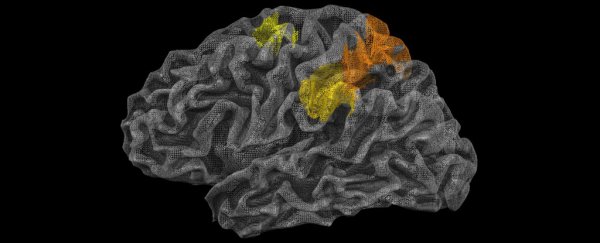Many science students might dread the more complex aspects of physics, but far removed from the mathematical equations that define how our physical world behaves, we each have an inner intuitive sense for how things will bounce, wobble, or fall.
Now, researchers say they've identified the brain region responsible for making these instinctive, immediate calculations for the movement of physical objects, dubbing it the brain's "physics engine".
"We run physics simulations all the time to prepare us for when we need to act in the world," says cognitive scientist Jason Fischer from Johns Hopkins University. "It is among the most important aspects of cognition for survival. But there has been almost no work done to identify and study the brain regions involved in this capability."
Interestingly, while we might think of these kinds of physical calculations as largely visual in nature – for example, trying to predict where a basketball might bounce after it hits the rim or backboard – the cerebral region that handles the actual work isn't in the brain's vision centre, but in our action planning areas: the premotor cortex and supplementary motor area.
"Our findings suggest that physical intuition and action planning are intimately linked in the brain," says Fischer. "We believe this might be because infants learn physics models of the world as they hone their motor skills, handling objects to learn how they behave. Also, to reach out and grab something in the right place with the right amount of force, we need real-time physical understanding."
To identify the region in our brain that makes physics-based calculations, Fischer and a team of researchers from MIT had 12 participants look at video of Jenga-style blocks assembled in a tower.
While scanning their brain activity via functional magnetic resonance imaging (fMRI), the researchers asked the participants to predict where they thought the blocks might land if the tower were to collapse.
The fMRI results showed that the premotor cortex and the supplementary motor area were the most responsive areas – whereas a simple visual test, in which the participants only had to identify whether the static tower contained more blue or yellow blocks, didn't stimulate activity in their physics engine.
You can actually try the Jenga test for yourself by watching the video below.
Regardless of whether you guess the correct responses based on each tower (there are three separate collapses in the video), the parts of the brain you're using when you try to figure it out are the premotor cortex and the supplementary motor area, according to the researchers.

The team found evidence of the same brain activity in two separate physics-based experiments. In one, the participants watched a video of two dots bouncing, and had to try to predict where the dots would bounce next.
In a final test, the participants simply watched short movie clips featuring lots of physics content while having their brain activity monitored.
Even without being asked to respond to the clips in any way – they only had to watch the video – the results showed that the brain's physics engine was stimulated, with the more physical content shown, the more the premotor cortex and supplementary motor area were activated.
"The brain activity reflected the amount of physical content in a movie, even if people weren't consciously paying attention to it," says Fischer. "This suggests that we are making physical inferences all the time, even when we're not even thinking about it."
It's worth pointing out that this was a very small study with only a small group taking part, so the findings will need to be replicated in larger research involving more people being tested.
But if the findings check out, the researchers say it could help lead to better designs for robots, built with physics engines that resemble our own. The research could also help us understand more about motor disorders like apraxia – where people have difficulty planning and carrying out physical movements.
It's not the first time researchers have found evidence of physics-based thinking in the brain. Earlier in the year, a team of Japanese scientists discovered even cats have a very basic grasp of physics, based on experiments involving containers that either rattled or were silent when shaken – which gave the animals a clue that something was contained inside them (or not).
We're finding out more and more out about the human brain all the time – with scientists identifying almost 100 brand-new brain regions just last month.
It's an exciting time for neuroscience, and we can't wait to find out just what else our heads have in store for us.
The findings are reported in Proceedings of the National Academy of Sciences.
